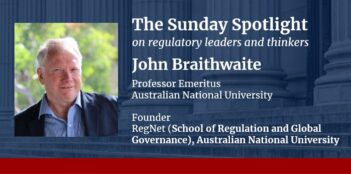
Scholar argues that prioritizing noncitizens convicted of crimes for deportation is unjustified.
Undocumented immigrants are estimated to be 100 times more likely to face deportation if they are criminally convicted. But one legal scholar argues that there is no good justification for that increased chance of deportation.
In an article published in the Georgetown Law Journal, David Hausman argues that recent immigration policy almost exclusively uses criminality to decide which noncitizens to deport—and he argues that this policy is unjustified.
Hausman, a postdoctoral fellow at the Regulation, Evaluation, and Governance Lab at Stanford Law School, views criminality-based deportation priorities as a social control mechanism with racially discriminatory consequences. According to Hausman, decisionmakers should adjust deportation priorities to weigh ties to the United States more heavily than they do criminality.
Hausman explains that U.S. Presidents have substantial discretion to determine who is deported because of their ability to determine enforcement priorities. Through the Immigration and Nationality Act and other statutes, the U.S. Congress has established that immigration violations can result in or enhance criminal consequences, and conversely, criminal violations can have impacts on an immigrant’s status. That statutory scheme, however, primarily defines deportable groups, rather than directing specific people to be deported, according to Hausman.
Presidents, then, have the prosecutorial discretion to fill the gaps, and they have used this discretion to filter deportations by criminality, Hausman observes. In 2014, President Barack Obama introduced the Priority Enforcement Program, which instructed Immigrations and Customs Enforcement (ICE) to focus enforcement efforts on noncitizens convicted of serious crimes. Under President Donald J. Trump, who deported more noncitizens without criminal convictions than his predecessor, being convicted of a crime made noncitizens at least 100 times more likely to be deported. And President Joseph R. Biden’s immigration policy has targeted noncitizens with aggravated felonies.
The criminality system has given ICE an easy job, Hausman suggests, as ICE officers pick up the majority of their detainees from jails and prisons after local police make arrests.
Hausman identifies several arguments in support of criminality as a basis for deportation and explains why he finds them unconvincing. For example, proponents argue that it is an effective crime control strategy. But Hausman counters that, legally, deportation is not meant to be a form of punishment. And he contends that these arguments ignore evidence that the crime rate among noncitizens is already lower than that of citizens and that immigration enforcement impacts crime very little, if at all.
Proponents also equate deportation to a sentencing enhancement that deportees deserve for being noncitizens. But status as a noncitizen is neither a criminal nor civil offense, Hausman argues, and this argument ignores the existence of criminal sentencing enhancements, independent of immigration enforcement.
Hausman also addresses the main immigration policy argument in favor of the current system: that it allows the government to screen immigrants on an ad hoc basis upon criminal conviction, placing all undocumented immigrants on a pseudo-probation. Hausman concedes that this would be a fair argument if no other factors were at play—but he argues that immigrants’ ties to the United States are an important factor.
Hausman argues that if deportations must continue, the executive should adopt a deportation policy that more prominently considers immigrants’ ties to the United States, which include family relationships, length of residence, and other community relationships.
Hausman asserts that these ties add to the costs of deportation. Greater ties to the United States dramatically heighten costs for the deported noncitizens themselves, who suffer not only the loss of existing ties but also the dearth of ties in the country to which they are deported. Stronger ties also result in greater harm to the people involved in those ties, including family, friends, and employers. Deportation can take both relationships and support systems from those people.
The current system harms noncitizens, argues Hausman. He points to the racially disparate consequences that follow from reliance on a criminal justice system that suffers from racial bias. He also contends that ICE’s emphasis on criminality means that noncitizens must operate under a stricter code of conduct than citizens. These phenomena place ICE in a racially discriminatory social control role, according to Hausman.
Hausman makes a few policy recommendations for better prioritizing ties to the United States. He suggests changing enforcement priorities to include bright-line rules about ties to the United States. Alternatively, the priorities could direct officers to consider ties as part of a holistic decisionmaking process. Hausman also suggests rethinking the connection between ICE detentions and local law enforcement, in an effort to avoid the racially discriminatory effects of criminal justice.
At the very least, Hausman contends, policymakers should gather information on immigrant ties to the United States, which is not currently collected or made available by ICE.
Hausman concludes that changing the current system is increasingly important, as the noncitizen population in the United States continues to establish roots. He argues that replacing criminality as the primary filter for deportation is critical to moving toward effective immigration policy and away from racial discrimination and social control.



